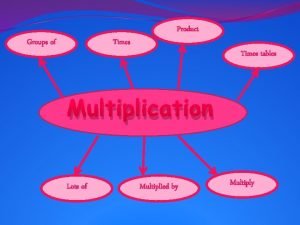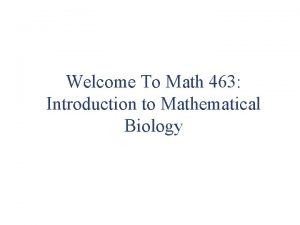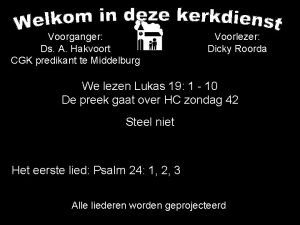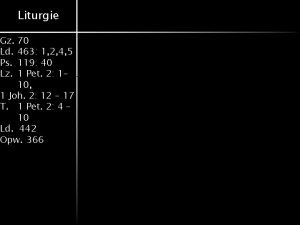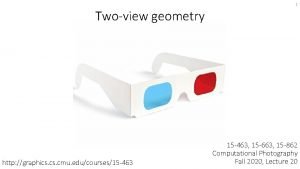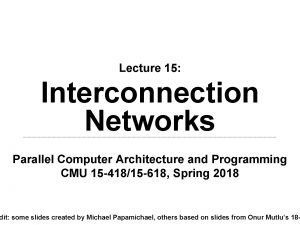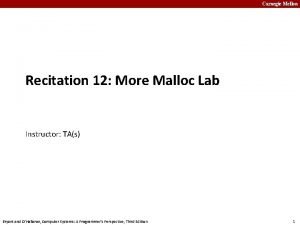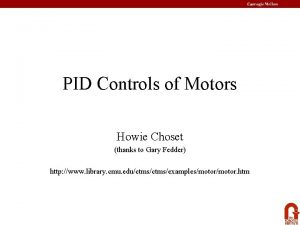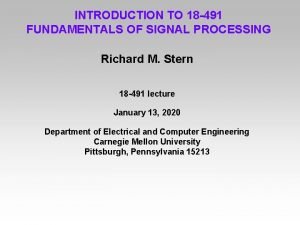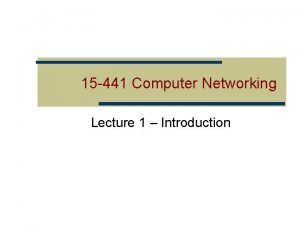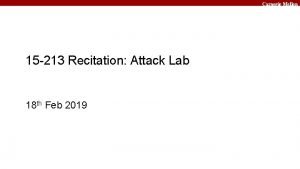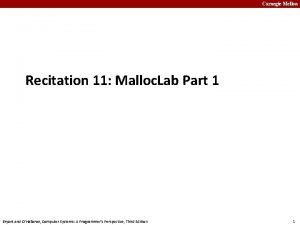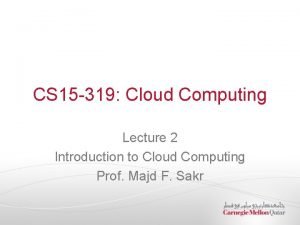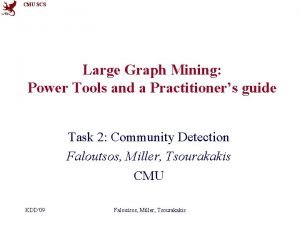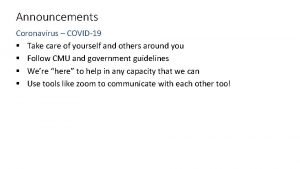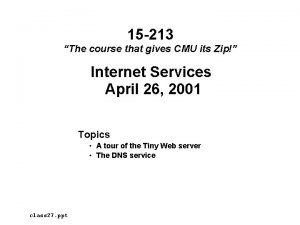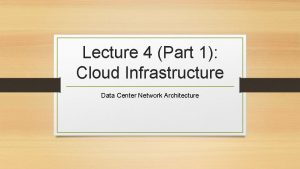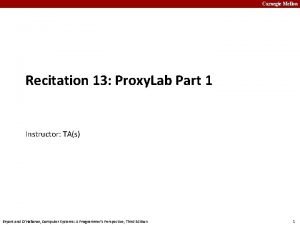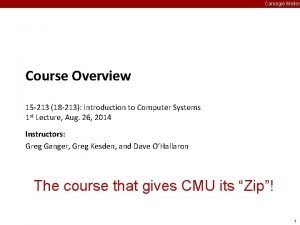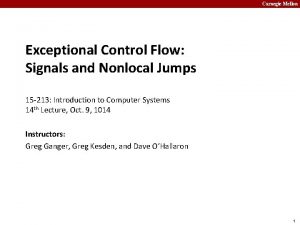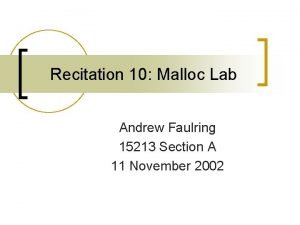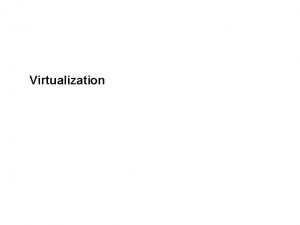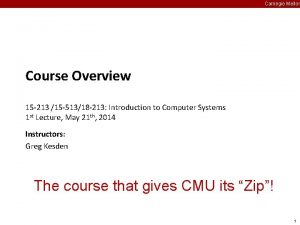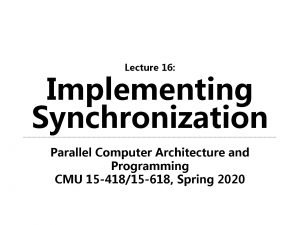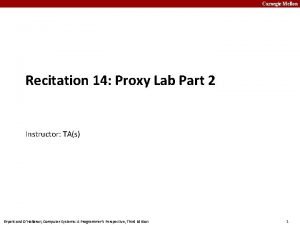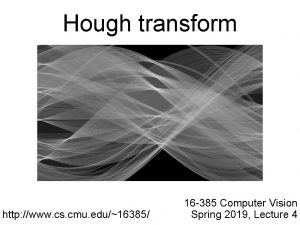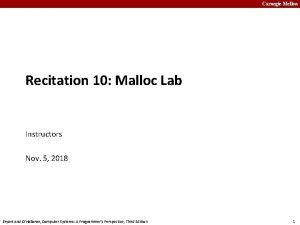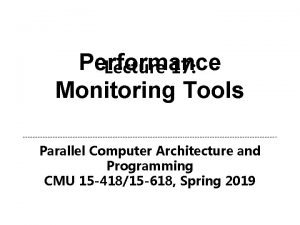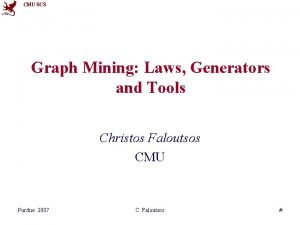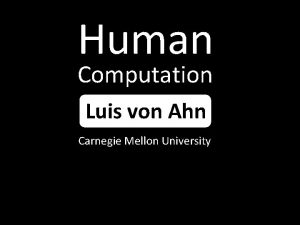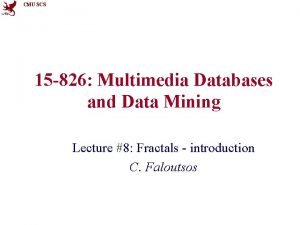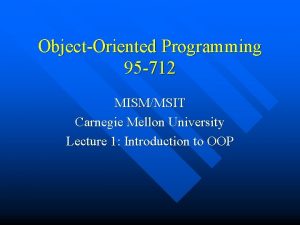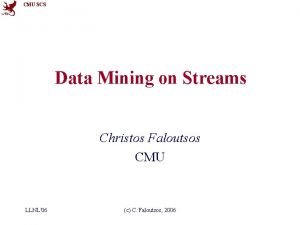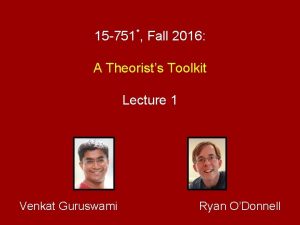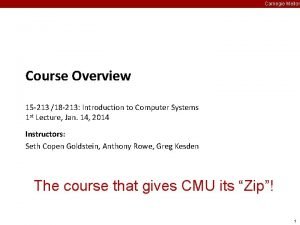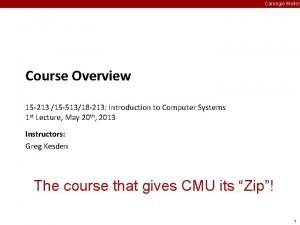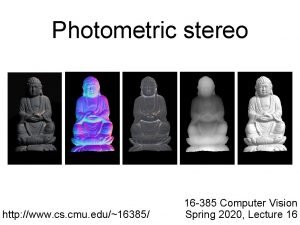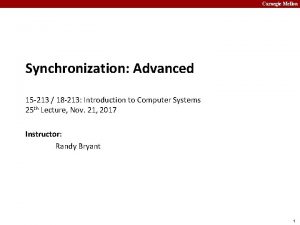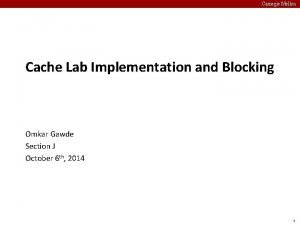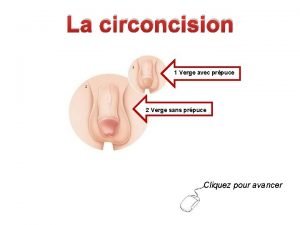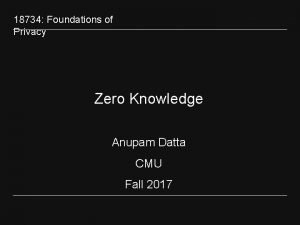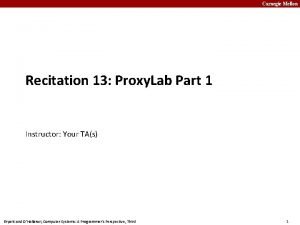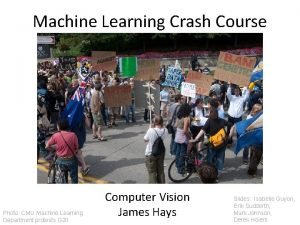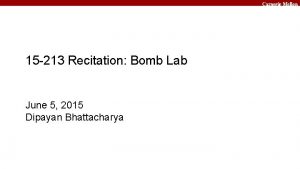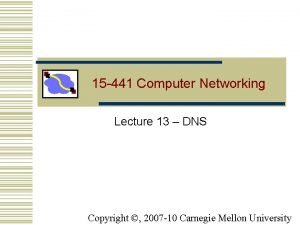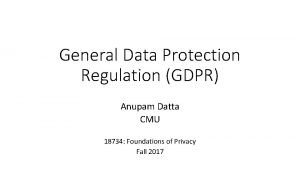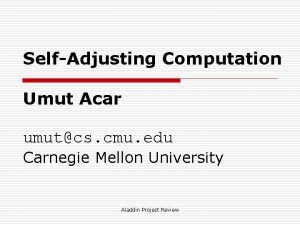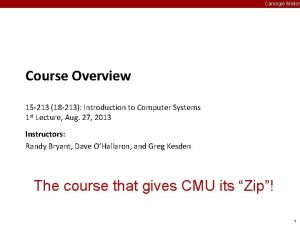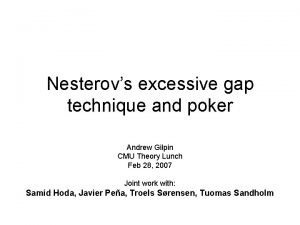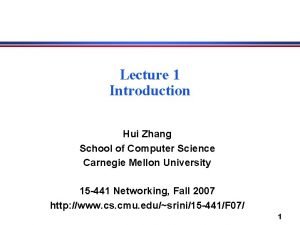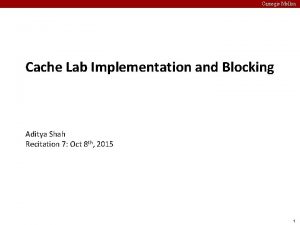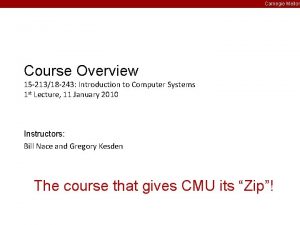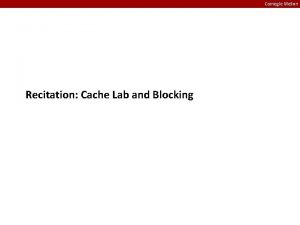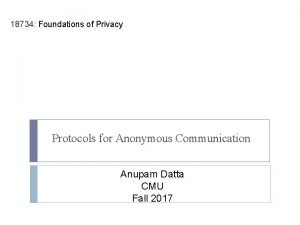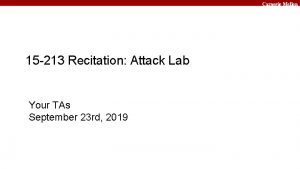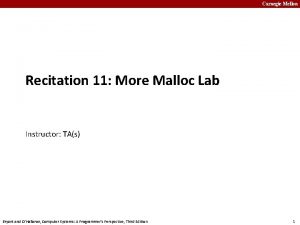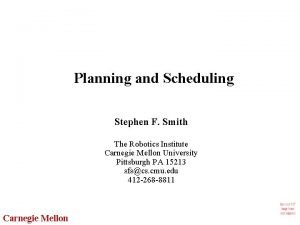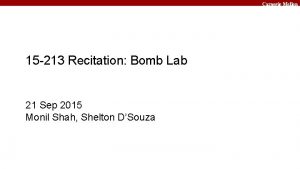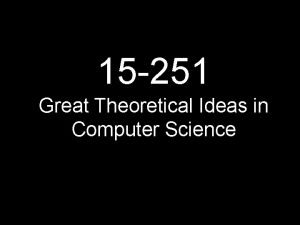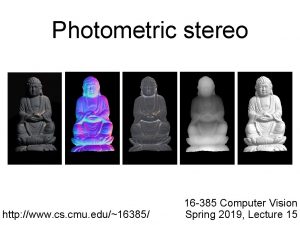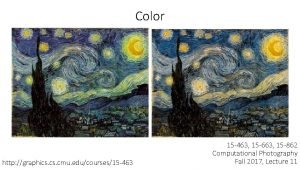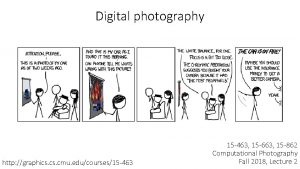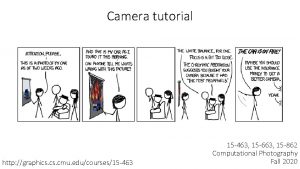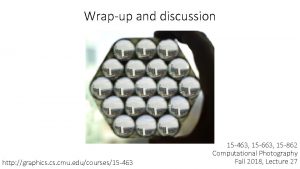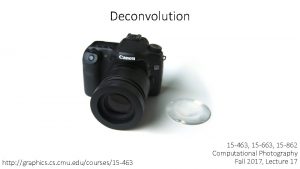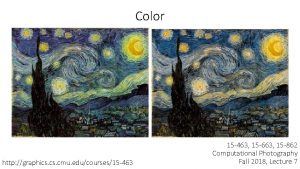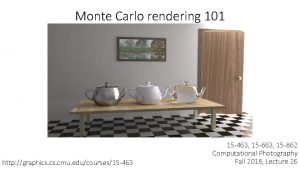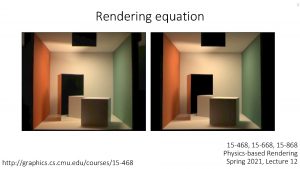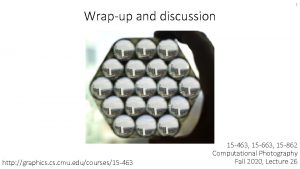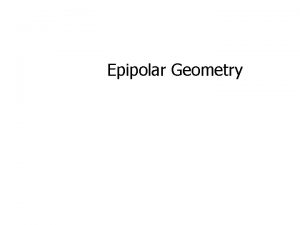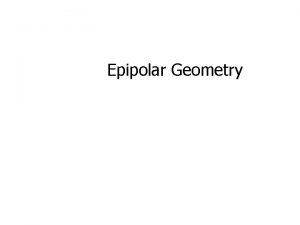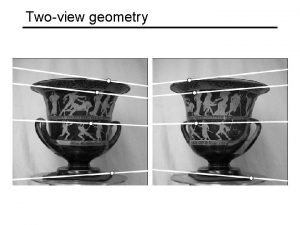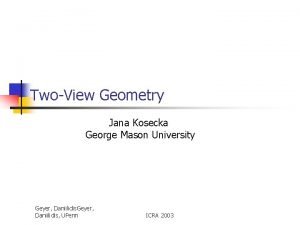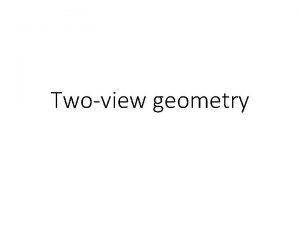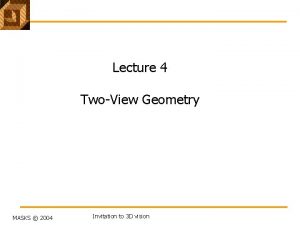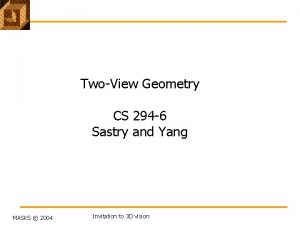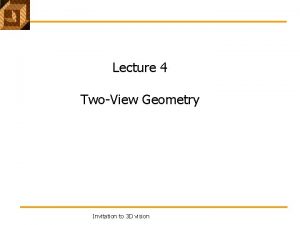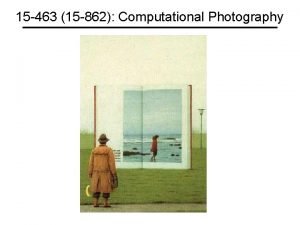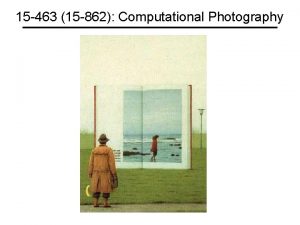Twoview geometry http graphics cmu educourses15 463 15




















































































![putting it together rigid motion coplanarity Essential Matrix [Longuet-Higgins 1981] putting it together rigid motion coplanarity Essential Matrix [Longuet-Higgins 1981]](https://slidetodoc.com/presentation_image/21613f1930d85c7b3d0597f93918071c/image-85.jpg)







































- Slides: 124

Two-view geometry http: //graphics. cmu. edu/courses/15 -463, 15 -663, 15 -862 Computational Photography Fall 2018, Lecture 15

Course announcements • Homework 4 is out. - Due October 26 th. - Start early: part 3 (lightfield capture) takes a lot of time to get right. - Any questions? • Due October 21 st: Project ideas posted on Piazza. • Extra office hours this afternoon, 5 -7 pm. • ECE Seminar tomorrow: Rajiv Laroia, “Is Computational Imaging the future of Photography? ” - New time and date: noon – 1: 30 pm, Scaife Hall 125

Light camera L 16 • Use multiple views (i. e. , lightfield) to refocus. • Use deconvolution to keep thin (i. e. , skip compound lens).

Overview of today’s lecture • Leftover from lecture 13 • Reminder about pinhole and lens cameras • Camera matrix. • Other camera models. • Camera calibration.

Slide credits Many of these slides were adapted from: • Kris Kitani (16 -385, Spring 2017). • Srinivasa Narasimhan (16 -720, Fall 2017).

Overview of today’s lecture • Leftover from lecture 13: camera calibration. • Triangulation. • Epipolar geometry. • Essential matrix. • Fundamental matrix. • 8 -point algorithm.

Triangulation

Triangulation image 1 image 2 Given camera 1 with matrix camera 2 with matrix

Triangulation Which 3 D points map to x? image 1 camera 1 with matrix image 2 camera 2 with matrix

Triangulation How can you compute this ray? image 1 camera 1 with matrix image 2 camera 2 with matrix

Triangulation Create two points on the ray: 1) find the camera center; and 2) apply the pseudo-inverse of P on x. Then connect the two points. + Why does this point map to x? image 1 camera 1 with matrix image 2 camera 2 with matrix

Triangulation How do we find the exact point on the ray? image 1 camera 1 with matrix + image 2 camera 2 with matrix

Triangulation Find 3 D object point Will the lines intersect? image 1 camera 1 with matrix image 2 camera 2 with matrix

Triangulation Find 3 D object point (no single solution due to noise) image 1 camera 1 with matrix image 2 camera 2 with matrix

Triangulation Given a set of (noisy) matched points and camera matrices Estimate the 3 D point

known Can we compute X from a single correspondence x?

known Can we compute X from two correspondences x and x’?

known Can we compute X from two correspondences x and x’? yes if perfect measurements

known Can we compute X from two correspondences x and x’? yes if perfect measurements There will not be a point that satisfies both constraints because the measurements are usually noisy Need to find the best fit

(homogeneous coordinate) Also, this is a similarity relation because it involves homogeneous coordinates (homorogeneous coordinate) Same ray direction but differs by a scale factor How do we solve for unknowns in a similarity relation?

(homogeneous coordinate) Also, this is a similarity relation because it involves homogeneous coordinates (inhomogeneous coordinate) Same ray direction but differs by a scale factor How do we solve for unknowns in a similarity relation? Remove scale factor, convert to linear system and solve with SVD.

(homogeneous coordinate) Also, this is a similarity relation because it involves homogeneous coordinates (inhomogeneous coordinate) Same ray direction but differs by a scale factor How do we solve for unknowns in a similarity relation? Remove scale factor, convert to linear system and solve with SVD!

Recall: Cross Product Vector (cross) product takes two vectors and returns a vector perpendicular to both cross product of two vectors in the same direction is zero remember this!!!

Same direction but differs by a scale factor Cross product of two vectors of same direction is zero (this equality removes the scale factor)



Using the fact that the cross product should be zero Third line is a linear combination of the first and second lines. (x times the first line plus y times the second line) One 2 D to 3 D point correspondence give you 2 equations

Using the fact that the cross product should be zero Third line is a linear combination of the first and second lines. (x times the first line plus y times the second line) One 2 D to 3 D point correspondence give you 2 equations

Now we can make a system of linear equations (two lines for each 2 D point correspondence)

Concatenate the 2 D points from both images sanity check! dimensions? How do we solve homogeneous linear system?

Concatenate the 2 D points from both images How do we solve homogeneous linear system? S V D !

Recall: Total least squares (Warning: change of notation. x is a vector of parameters!) (matrix form) constraint minimize subject to minimize (Rayleigh quotient) Solution is the eigenvector corresponding to smallest eigenvalue of

Epipolar geometry

Epipolar geometry Image plane

Epipolar geometry Baseline Image plane

Epipolar geometry Baseline Image plane Epipole (projection of o’ on the image plane)

Epipolar geometry Epipolar plane Baseline Image plane Epipole (projection of o’ on the image plane)

Epipolar geometry Epipolar line (intersection of Epipolar plane and image plane) Epipolar plane Baseline Image plane Epipole (projection of o’ on the image plane)

Quiz What is this?

Quiz Epipolar plane

Quiz What is this? Epipolar plane

Quiz Epipolar line (intersection of Epipolar plane and image plane) Epipolar plane

Quiz Epipolar line (intersection of Epipolar plane and image plane) Epipolar plane What is this?

Quiz Epipolar line (intersection of Epipolar plane and image plane) Epipolar plane Epipole (projection of o’ on the image plane)

Quiz Epipolar line (intersection of Epipolar plane and image plane) Epipolar plane What is this? Epipole (projection of o’ on the image plane)

Quiz Epipolar line (intersection of Epipolar plane and image plane) Epipolar plane Baseline Epipole (projection of o’ on the image plane)

Epipolar constraint Potential matches for lie on the epipolar line

Epipolar constraint Potential matches for lie on the epipolar line

The point x (left image) maps to a ______ in the right image The baseline connects the ______ and ______ An epipolar line (left image) maps to a _____ in the right image An epipole e is a projection of the _______ on the image plane All epipolar lines in an image intersect at the _______

Converging cameras Where is the epipole in this image?

Converging cameras here! Where is the epipole in this image? It’s not always in the image

Parallel cameras Where is the epipole?

Parallel cameras epipole at infinity

The epipolar constraint is an important concept for stereo vision Task: Match point in left image to point in right image Left image Right image How would you do it?

Recall: Epipolar constraint Potential matches for lie on the epipolar line

The epipolar constraint is an important concept for stereo vision Task: Match point in left image to point in right image Left image Right image Want to avoid search over entire image Epipolar constraint reduces search to a single line

The epipolar constraint is an important concept for stereo vision Task: Match point in left image to point in right image Left image Right image Want to avoid search over entire image Epipolar constraint reduces search to a single line How do you compute the epipolar line?

The essential matrix

Recall: Epipolar constraint Potential matches for lie on the epipolar line

Given a point in one image, multiplying by the essential matrix will tell us the epipolar line in the second view.

Motivation The Essential Matrix is a 3 x 3 matrix that encodes epipolar geometry Given a point in one image, multiplying by the essential matrix will tell us the epipolar line in the second view.

Representing the … Epipolar Line in vector form If the point is on the epipolar line then

Epipolar Line in vector form If the point is on the epipolar line then

Recall: Dot Product dot product of two orthogonal vectors is zero

vector representing the line is normal (orthogonal) to the plane vector representing the point x is inside the plane Therefore:

So if and then

So if and then

Essential Matrix vs Homography What’s the difference between the essential matrix and a homography?

Essential Matrix vs Homography What’s the difference between the essential matrix and a homography? They are both 3 x 3 matrices but … Essential matrix maps a point to a line Homography maps a point to a point

Where does the Essential matrix come from?


Does this look familiar?

Camera-camera transform just like world-camera transform

These three vectors are coplanar

If these three vectors are coplanar then

If these three vectors are coplanar then

Recall: Cross Product Vector (cross) product takes two vectors and returns a vector perpendicular to both

If these three vectors are coplanar then

If these three vectors are coplanar then

putting it together rigid motion coplanarity

Cross product Can also be written as a matrix multiplication Skew symmetric

putting it together rigid motion coplanarity

putting it together rigid motion coplanarity

putting it together rigid motion coplanarity
![putting it together rigid motion coplanarity Essential Matrix LonguetHiggins 1981 putting it together rigid motion coplanarity Essential Matrix [Longuet-Higgins 1981]](https://slidetodoc.com/presentation_image/21613f1930d85c7b3d0597f93918071c/image-85.jpg)
putting it together rigid motion coplanarity Essential Matrix [Longuet-Higgins 1981]

properties of the E matrix Longuet-Higgins equation (points in normalized coordinates)

properties of the E matrix Longuet-Higgins equation Epipolar lines (points in normalized coordinates)

properties of the E matrix Longuet-Higgins equation Epipolar lines Epipoles (points in normalized camera coordinates)

Recall: Epipolar constraint Potential matches for lie on the epipolar line

Given a point in one image, multiplying by the essential matrix will tell us the epipolar line in the second view. Assumption: points aligned to camera coordinate axis (calibrated camera)

How do you generalize to uncalibrated cameras?

The fundamental matrix

The Fundamental matrix is a generalization of the Essential matrix, where the assumption of calibrated cameras is removed

The Essential matrix operates on image points expressed in normalized coordinates (points have been aligned (normalized) to camera coordinates) camera point image point

The Essential matrix operates on image points expressed in normalized coordinates (points have been aligned (normalized) to camera coordinates) camera point image point Writing out the epipolar constraint in terms of image coordinates

Same equation works in image coordinates! it maps pixels to epipolar lines

F properties of the E matrix Longuet-Higgins equation Epipolar lines Epipoles F F F (points in image coordinates)

Breaking down the fundamental matrix Depends on both intrinsic and extrinsic parameters

Breaking down the fundamental matrix Depends on both intrinsic and extrinsic parameters How would you solve for F?

The 8 -point algorithm

Assume you have M matched image points Each correspondence should satisfy How would you solve for the 3 x 3 F matrix?

Assume you have M matched image points Each correspondence should satisfy How would you solve for the 3 x 3 F matrix? S V D

Assume you have M matched image points Each correspondence should satisfy How would you solve for the 3 x 3 F matrix? Set up a homogeneous linear system with 9 unknowns

How many equation do you get from one correspondence?

ONE correspondence gives you ONE equation

Set up a homogeneous linear system with 9 unknowns How many equations do you need?

Each point pair (according to epipolar constraint) contributes only one scalar equation Note: This is different from the Homography estimation where each point pair contributes 2 equations. We need at least 8 points Hence, the 8 point algorithm!

How do you solve a homogeneous linear system?

How do you solve a homogeneous linear system? Total Least Squares minimize subject to

How do you solve a homogeneous linear system? Total Least Squares minimize subject to S V D !

Eight-Point Algorithm 0. (Normalize points) 1. Construct the M x 9 matrix A 2. Find the SVD of A 3. Entries of F are the elements of column of V corresponding to the least singular value 4. (Enforce rank 2 constraint on F) 5. (Un-normalize F)

Eight-Point Algorithm 0. (Normalize points) 1. Construct the M x 9 matrix A 2. Find the SVD of A 3. Entries of F are the elements of column of V corresponding to the least singular value 4. (Enforce rank 2 constraint on F) 5. (Un-normalize F) See Hartley. Zisserman for why we do this

Eight-Point Algorithm 0. (Normalize points) 1. Construct the M x 9 matrix A 2. Find the SVD of A 3. Entries of F are the elements of column of V corresponding to the least singular value 4. (Enforce rank 2 constraint on F) 5. (Un-normalize F) How do we do this?

Eight-Point Algorithm 0. (Normalize points) 1. Construct the M x 9 matrix A 2. Find the SVD of A 3. Entries of F are the elements of column of V corresponding to the least singular value 4. (Enforce rank 2 constraint on F) 5. (Un-normalize F) How do we do this? S V D !

Enforcing rank constraints Problem: Given a matrix F, find the matrix F’ of rank k that is closest to F, Solution: Compute the singular value decomposition of F, Form a matrix Σ’ by replacing all but the k largest singular values in Σ with 0. Then the problem solution is the matrix F’ formed as,

Eight-Point Algorithm 0. (Normalize points) 1. Construct the M x 9 matrix A 2. Find the SVD of A 3. Entries of F are the elements of column of V corresponding to the least singular value 4. (Enforce rank 2 constraint on F) 5. (Un-normalize F)

Example

epipolar lines



Where is the epipole? How would you compute it?

The epipole is in the right null space of F How would you solve for the epipole?

The epipole is in the right null space of F How would you solve for the epipole? S V D !

References Basic reading: • Szeliski textbook, Section 8. 1 (not 8. 1. 1 -8. 1. 3), Chapter 11, Section 12. 2. • Hartley and Zisserman, Section 11. 12.
 43 times tables
43 times tables Math 463
Math 463 Liedboek 463
Liedboek 463 Gcb registration
Gcb registration Opwekking 463
Opwekking 463 Triangulation
Triangulation Graphics monitors in computer graphics
Graphics monitors in computer graphics Computer graphics chapter 1 ppt
Computer graphics chapter 1 ppt Geometry in computer graphics
Geometry in computer graphics Electron geometry and molecular geometry
Electron geometry and molecular geometry Electron domain geometry vs molecular geometry
Electron domain geometry vs molecular geometry Bonding theories
Bonding theories Http //pelatihan tik.ung.ac.id
Http //pelatihan tik.ung.ac.id Http //mbs.meb.gov.tr/ http //www.alantercihleri.com
Http //mbs.meb.gov.tr/ http //www.alantercihleri.com 15-110 cmu
15-110 cmu Tw cmu xxx
Tw cmu xxx Cmu parallel computing
Cmu parallel computing Malloc lab cmu
Malloc lab cmu Cmu library
Cmu library Richard stern cmu
Richard stern cmu 15-441
15-441 Cmu immunization
Cmu immunization Cmu attack lab
Cmu attack lab Malloc lab cmu
Malloc lab cmu Eric xing cmu
Eric xing cmu Cmu cloud computing
Cmu cloud computing Group x cmu
Group x cmu Leaf classification
Leaf classification Cmu 15-213
Cmu 15-213 Brad myers cmu
Brad myers cmu Cmu 14848
Cmu 14848 Cmu proxy lab
Cmu proxy lab 18-213 cmu
18-213 cmu Sio cmu
Sio cmu Canvas cmu
Canvas cmu Masonry veneer curtain walls:
Masonry veneer curtain walls: 15213 malloc lab
15213 malloc lab Cmu vmware
Cmu vmware Ghc cmu
Ghc cmu Synchronization in computer architecture
Synchronization in computer architecture 18742 cmu
18742 cmu David garlan cmu
David garlan cmu Anthony rowe cmu
Anthony rowe cmu Bibliothèque cmu
Bibliothèque cmu Zack weinberg cmu
Zack weinberg cmu Proxy lab cmu
Proxy lab cmu Canvas.cmu edu
Canvas.cmu edu Hui zhang cmu
Hui zhang cmu Deep learning vs machine learning
Deep learning vs machine learning Vyas sekar
Vyas sekar Cmu 16720
Cmu 16720 Cmu malloc lab
Cmu malloc lab Cmu speech recognition
Cmu speech recognition Intelremotemond
Intelremotemond Cmu 213
Cmu 213 Cmu mld
Cmu mld Cmu library
Cmu library Luis von ahn cmu
Luis von ahn cmu Cmu
Cmu 15-440 cmu
15-440 cmu Shell lab cmu
Shell lab cmu Cmu mism
Cmu mism Tom cortina
Tom cortina Data mining cmu
Data mining cmu Chris atkeson
Chris atkeson 15751 cmu
15751 cmu Cmu autolab
Cmu autolab Cmu bomb lab
Cmu bomb lab Spectral clustering
Spectral clustering 14848 cmu
14848 cmu Cmu 15-513
Cmu 15-513 Cmu vpn
Cmu vpn Gregory kesden cmu
Gregory kesden cmu 16385 cmu
16385 cmu 18-213 cmu
18-213 cmu Cmu cache lab
Cmu cache lab Circoncision
Circoncision 18734 cmu
18734 cmu Ryan o'donnell cmu
Ryan o'donnell cmu 16-385 computer vision
16-385 computer vision Proxy lab cmu
Proxy lab cmu Hoda heidari cmu
Hoda heidari cmu Cmu machine learning course
Cmu machine learning course Cmu sio
Cmu sio Bomb lab solutions
Bomb lab solutions 15441 cmu
15441 cmu Anupam datta cmu
Anupam datta cmu Cmu robotics minor
Cmu robotics minor Cmu proxy
Cmu proxy Sandboxing urban dictionary
Sandboxing urban dictionary Cmu rapid prototyping
Cmu rapid prototyping Lorrie faith cranor
Lorrie faith cranor Self adjusting computation
Self adjusting computation Cmu bioinformatics
Cmu bioinformatics David eber cmu
David eber cmu Healthconnect cmu
Healthconnect cmu Cmu distributed systems
Cmu distributed systems 15-213 cmu
15-213 cmu Cmu theory lunch
Cmu theory lunch Tetrad cmu
Tetrad cmu Cmu it account
Cmu it account 16385 cmu
16385 cmu Canvas cmu
Canvas cmu Brian railing cmu
Brian railing cmu Andrew ng machine learning slides
Andrew ng machine learning slides Hui zhang cmu
Hui zhang cmu Cache blocking matrix transpose
Cache blocking matrix transpose Bill nace cmu
Bill nace cmu Hci minor cmu
Hci minor cmu Cmu slice reimbursement
Cmu slice reimbursement Cache lab
Cache lab Cmu library
Cmu library Mary widom cmu
Mary widom cmu Cmu embedded systems
Cmu embedded systems Cmu 18734
Cmu 18734 Cmu graph theory
Cmu graph theory Cmu attack lab
Cmu attack lab Garbled bytes
Garbled bytes Stephen smith cmu
Stephen smith cmu David blackman
David blackman Cmu snake robot
Cmu snake robot 15213 bomb lab
15213 bomb lab Great theoretical ideas in computer science
Great theoretical ideas in computer science Cmu 16385
Cmu 16385 Machine learning definition mitchell
Machine learning definition mitchell
